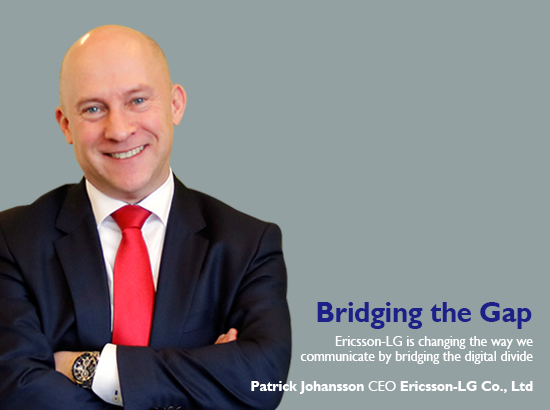Feature Stories
- Home
- Why KOREA
- Feature Stories

Ericsson-LG is changing the way we communicate by bridging the digital divide
No foreign company has done business with South Korea quite like Ericsson. The telecommunications company’s ties with Korea date back to 1896, just 20 years after its founding in Stockholm, Sweden. It was at this time that Ericsson installed Korea’s first magneto telephone switch in the royal palace. Since then, Korea has become an irreplaceable partner for Ericsson and the two have been finding new and innovative ways for cooperation.
The most noteworthy collaboration was in 2010 when Ericsson bought Canadian telecommunications company Nortel's
stake in its joint venture with LG Electronics, subsequently changing the name from LG-Nortel to Ericsson-LG
(Ericsson currently holds a 75 percent stake, with LG holding 25 percent). With the establishment of the R&D Center in
Anyang, Ericsson-LG has been at the forefront of the upcoming Fourth Industrial Revolution, or as CEO Patrick
Johansson, likes to call it, “the Fourth Industrial Evolution”.
Even while talking about something as daunting as technological revolution (or evolution), Johansson’s demeanor is affable and engaging. When asked why Ericsson decided to expand its business here, his eyes light up. “It’s very apparent that Korea has an advanced and mature market, and we’re a company with leading technology. The country’s strong R&D infrastructure, strategic location and optimal business environment were some reasons why we decided to pursue a joint venture with LG.”
South Korea has long emerged as a magnet for big R&D spenders like Ericsson-LG, and with good reason—it
spends a significant part of its GDP on R&D. According to the Organization for Economic Cooperation and Development
(OECD) report on the global state of science, technology and industry, Korea spends 4.29 percent of its GDP on R&D,
almost double the average amount spent by other OECD countries. Johansson notes that the company takes full advantage of such infrastructure, with over half of its employees focusing on R&D development at the Anyang center.
The high penetration rate of smartphone usage was another factor that drew Ericsson to Korea. Over 90 percent of
Koreans use a smartphone and the number of cellphones being used in the country has surpassed 60 million—that’s
almost 10 million more than Korea’s total population. And it’s this kind of environment and local market that has helped the
company transform the telecommunications industry as a whole.
“Our vision is to create a truly net-worked society where every person is empowered to reach their full potential,” says Johansson. Ericsson-LG is well on its way of achieving this vision, being the first network equipment manufacturer to showcase the next-generation network 5G last year. The much-anticipated 5G network is 350 times faster than the current Long-Term Evolution network and the company hopes to launch it to the public in time for the 2018 PyeongChang Olympics.
For Johansson, however, 5G is more than just faster speed; the network creates a new variety of powerful services that
blur the boundaries between industries. Case in point, the company worked with Korea’s largest wireless carrier SK Telecom and BMW in 2016 to reveal the most advanced 5G outdoor mobility trial, including the first multivehicular 5G trials. They were conducted successfully on a 5G test network installed at the advanced BMW car test track in Yeongjong Island. SK Telecom and
Ericsson-LG deployed network slicing and 5G radio network infrastructure to cover a complete track in the BMW driving center. The trial with the connected test cars showed that 5G performance will support V2X (Vehicular Connectivity)services that require low latency and consistent high bi-directional throughput. Such demonstration of 5G-based connected car technologies marks the very first step towards achieving fully autonomous driving.
As one of the most wired and connected countries on earth, Korea serves as a platform for telecommunications companies to flourish, but it also can cause stiff competition among such businesses. So how does Ericsson-LG rise differentiate itself? By thinking ‘glocal’ and working with local companies both big and small. Most notably, it held an event called ‘ETNS (Enabling The Networked Society)’, offering Korea’s promising startups the chance to work with the company. Participating enterprises were able to present their business proposals directly in front of Johansson. And by thinking glocally, Ericsson’s transition into Korea
has been relatively smooth compared to that of other foreign companies. Establishing a joint venture with a Korean company like LG has helped bridge cultural challenges. But Johansson knows there is still room for improvement. “There are always opportunities for more dialogue, especially between the Korean government and foreign companies. Korea should continue to be open to global businesses and fully utilize its many trade agreements.” He adds that Ericsson-LG is working with agencies like KOTRA to exchange new ideas and help improve Korea’s business environment.
By Esther Oh (estheroh@kotra.or.kr)
Executive Consultant/Invest Korea










